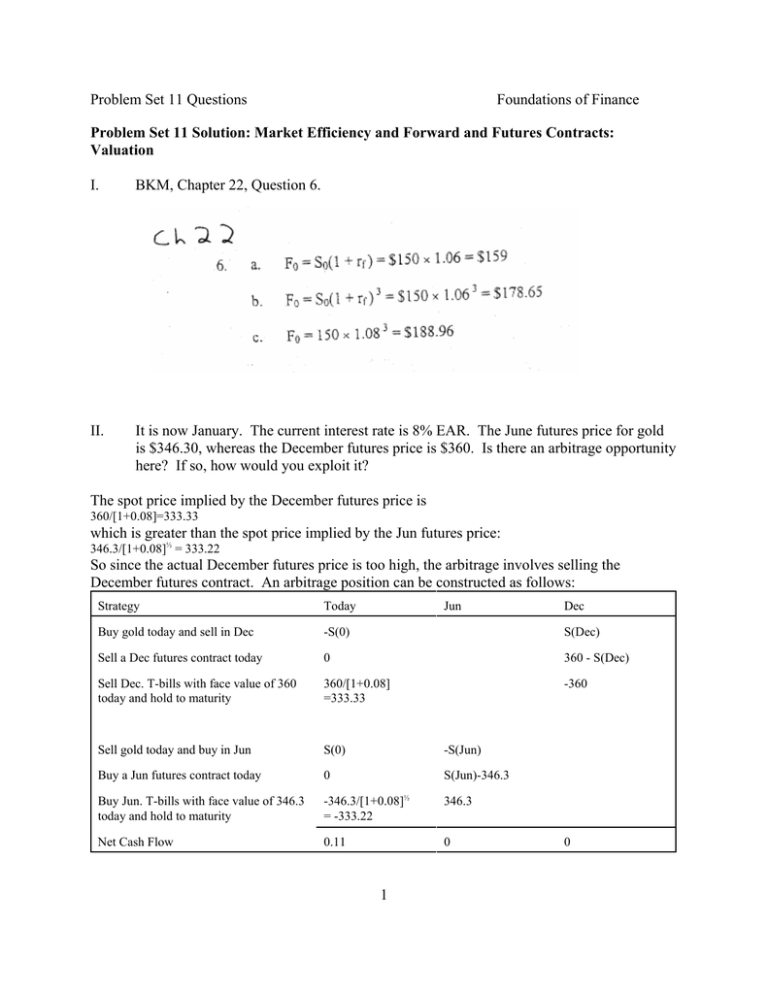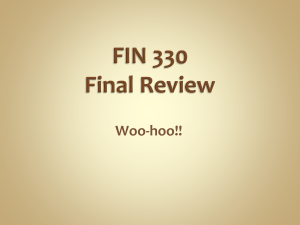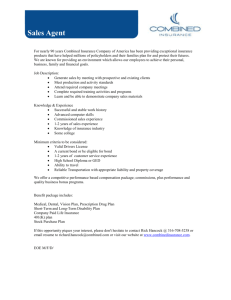Problem Set 11 Questions Foundations of Finance I. BKM, Chapter 22, Question 6.
advertisement

Problem Set 11 Questions Foundations of Finance Problem Set 11 Solution: Market Efficiency and Forward and Futures Contracts: Valuation I. BKM, Chapter 22, Question 6. II. It is now January. The current interest rate is 8% EAR. The June futures price for gold is $346.30, whereas the December futures price is $360. Is there an arbitrage opportunity here? If so, how would you exploit it? The spot price implied by the December futures price is 360/[1+0.08]=333.33 which is greater than the spot price implied by the Jun futures price: 346.3/[1+0.08]½ = 333.22 So since the actual December futures price is too high, the arbitrage involves selling the December futures contract. An arbitrage position can be constructed as follows: Strategy Today Jun Buy gold today and sell in Dec -S(0) S(Dec) Sell a Dec futures contract today 0 360 - S(Dec) Sell Dec. T-bills with face value of 360 today and hold to maturity 360/[1+0.08] =333.33 -360 Sell gold today and buy in Jun S(0) -S(Jun) Buy a Jun futures contract today 0 S(Jun)-346.3 Buy Jun. T-bills with face value of 346.3 today and hold to maturity -346.3/[1+0.08]½ = -333.22 346.3 Net Cash Flow 0.11 0 1 Dec 0 Problem Set 11 Questions III. Foundations of Finance The S&P portfolio pays a dividend of 2% annually. Its current value is 1020. The T-bill rate is 5% EAR. Suppose the S&P futures price for delivery in one year is 1060. Construct an arbitrage opportunity. Assume the dividend of 2% is paid in one year hence. Forward-spot parity implies a forward price that satisfies FT(0) dT(0) - C(tc) dtc(0) = S(0) FT(0)/1.05 + 1020x0.02 /1.05 = 1020 FT(0) = 1050.6 which is less than the available forward price. Since the available forward price is too high, want to sell forward contracts and buy the underlying: Strategy 0 1 Buy index at 0 and sell at 1 -1020 S(1) + 1020x0.02 Sell a forward contract at 0 which delivers index at 1 0 1060 - S(1) Sell 1-yr T-bills at 0 with face value of (1060+20.4) 1080.4/1.05 -1080.4 Net Cash Flow 8.95 0 This strategy is an arbitrage opportunity. IV. BKM, Chapter 23, Question 6. For part c, assume that your portfolio consists of 60% in equities and 40% in T-bills. 2 Problem Set 11 Questions Foundations of Finance V. The following formula converts discount bond discount factors to forward contract discount factors (it was introduced earlier in Lecture Notes 16-18): dt,t+τ(0) = dt+τ(0) /dt(0)? Is this formula consistent with the spot futures parity theorem? Explain why or why not. (Hint. Think about dt,t+τ(0) as referring to the forward price at time 0 for delivery of a τ-discount bond at time t.) Consider spot forward parity for a forward contract to deliver at time t a discount bond maturing at (t+τ) with a face value of $1. At time 0, the underlying is a (t+τ) period discount bond so S(0) = dt+τ(0). There is no carrying costs or negative carring costs associated with holding a discount bond. So if Ft(0) is the forward price, spot forward parity says that: Ft(0) = [1+y*t(0)]t S(0). So Ft(0) = [1+y*t(0)]t dt+τ(0) = [1/dt(0)] dt+τ(0). Now, Ft(0) is the forward price for the delivery at t of a discount bond maturing at (t+τ) with face value of $1. Thus, Ft(0) = dt,t+τ(0) and so dt,t+τ(0) = dt+τ(0) /dt(0) which is the stated relation. VI. BKM, Chapter 23, Question 12. Since the forward price is higher than implied by covered interest parity (say $1.58/£), want to buy the synthetic 1-year $-denominated discount bond and sell the 1-year $-denominated discount bond: Strategy 0 1 Sell $1 of 1-year $-denominated discount bonds at time 0 and close out at 1 $1 -$1.04 Sell a forward contract at 0 which delivers [1/1.6][1+ 0.08] = 0.675 £ at time 1 0 [$1.58-£1] x 0.675 = $1.58 x 0.675 - £0.675 Buy $1 worth of £ at 0 (£1/1.6) and invest in 1-year £-denominated discount bonds and hold til maturity. -$1 £ [1/1.6][1+ 0.08] = £0.675 Net Cash Flow 0 1.0665 - 1.04 = 0.0265 This strategy is an arbitrage opportunity. 3 Problem Set 11 Questions VII. Foundations of Finance Answer. A. B. C. No. The price may fully reflect all information contained in past prices and be weak form efficient even though price does not reflect all information in IBM’s annual report. Yes. Since IBM’s annual report is publicly available after its release date, price does not fully reflect all publicly available information and so the market is not semi strong form efficient. Yes. If the price does not reflect all publicly available information then it does not reflect all existing information. Thus, the market is not strong form efficient. 4






